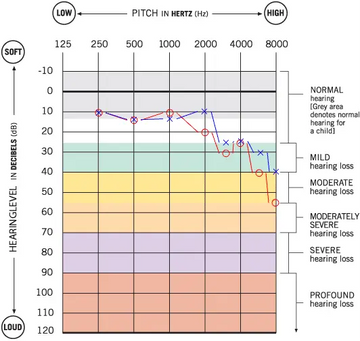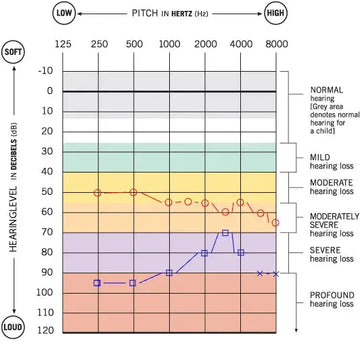Abstract
This case study follows Mr. Billow*, a 78-year-old man with high-frequency hearing loss due to age-related changes (presbycusis) and years of noise exposure from military service. First seen in 2015, he was found to have severe high-frequency hearing loss in his right ear and moderate high-frequency loss in his left; however, he was not yet ready for hearing aids. By 2021, his high-frequency hearing had declined further, leading him to try Widex Moment 440 Rechargeable Receiver-In-the-Ear (RIC) hearing aids, which helped him in conversations, especially in noisy environments. At a 2023 follow-up, his hearing remained stable, but adjustments were made to his hearing aids to address communication issues at home, as noted by his spouse. He returned to the clinic 9 months later in 2024 with concerns of decreased hearing sensitivity, as observed by his wife. He also expressed interest in newer hearing aids, such as the Widex SmartRIC R and Phonak Infinio Sphere R RIC. This case highlights the importance of personalized hearing care, regular follow-ups, and leveraging advancements in hearing technology to improve quality of life.
Introduction
Incidence and Prevalence of High-Frequency Sensorineural Hearing Loss (Presbycusis and Noise-induced):
High-frequency sensorineural hearing loss, which affects the ability to hear high-pitched sounds, is common in older adults and people exposed to loud noises over time. High frequencies are essential for understanding parts of speech, so this kind of loss can impact communication (World Health Organization, 2024).
High-frequency hearing loss, often due to aging (presbycusis) or exposure to loud noises, is increasingly common, particularly among older adults and individuals with a history of noise exposure. As of recent data, over 50% of U.S. adults above age 70 experience hearing loss, largely in the high frequencies, which is commonly linked to presbycusis (NIDCD, 2021).
Noise-induced hearing loss (NIHL) often appears due to occupational or environmental noise exposure, such as military service, and may even affect individuals as young as 20 (NIDCD, 2017). Currently, about 44 million U.S. adults have hearing loss, with estimates suggesting this number could rise to over 73 million by 2060 (NIDCD, 2021; WHO, 2024). Approximately 24% of U.S. adults aged 20 to 69 show signs of NIHL, characterized by high-frequency hearing impairment, with 6% experiencing bilateral symptoms.
NIHL can impair the ability to discern speech sounds in noisy environments, underscoring the importance of hearing protection and regular hearing assessments (Natarajan & Stankovic, 2023).
Mr. Billow’s Case History
Mr. Billow was first seen at an audiology clinic in 2015 for a comprehensive hearing evaluation. The results revealed normal to down-sloping moderately-severe high-frequency sensorineural hearing loss in his right ear and normal to down-sloping mild-moderate high-frequency sensorineural hearing loss in his left ear, consistent with both presbycusis and noise-induced damage from his military background. Despite his hearing challenges, he initially hesitated about pursuing hearing aids and opted to wait.

Mr. Billow’s 2021 Decibel Chart
In 2021, he returned to the clinic after noticing further deterioration in his hearing, particularly in the right ear’s high-frequency range.

Mr. Billow’s 2021 Decibel Chart
This change prompted him to consider amplification, and he selected the Widex Moment 440 R RIC hearing aids. These devices provided substantial improvement, particularly in speech comprehension during background noise, although Mr. Billow reported continued difficulty in very loud environments at his hearing aid follow-up visits. Adjustments were made to reduce background noise and enhance speech clarity over the noise. He was satisfied with the changes. Recommendations to return to the clinic for a hearing aid check or annual hearing test were provided to Mr. Billows.

Mr. Billow’s Widex Moment 440 R RIC Hearing Aid
Continued Challenges and`
High-frequency hearing loss can make speech understanding particularly challenging, especially in the presence of background noise, as the brain relies on higher frequencies for distinguishing consonants (Nelson & Hinojosa, 2006). Mr. Billow adapted well to the Widex Moment 440 R RIC hearing aids, reporting noticeable improvements in speech perception. However, he continued to face difficulties in louder environments, a common limitation with high-frequency loss even when using amplification. To cope, he began using compensatory strategies, such as selecting quieter seating or outdoor dining spaces, which helped reduce frustration in social settings.
During his early Spring 2023 follow-up visit, his hearing remained stable, but his spouse reported difficulties with communication at home. Based on this feedback, adjustments were made to his hearing aids to enhance listening comfort in quieter settings.

Mr. Billow’s 2023 Decibel Chart
Mr. Billow returned to the clinic less than 9 months after his previous appointment due to concerns about not hearing from his wife at home. He reported that he continues to hear his family and friends essentially well; however, his wife expressed that he was not responding well to her at home. An updated hearing test from Fall 2024 revealed a slight decrease in the right ear and left hearing sensitivity, with a notable decrease in the low and middle pitches for the left ear. Mr. Billow’s hearing aids were re-programmed based on his new hearing test. He noticed an improvement in his hearing sensitivity after the adjustments were made.

Mr. Billow’s 2024 Decibel Chart
Future Considerations with New Hearing Aid Technology
During the hearing aid appointment, it was discussed with Mr Billow about possible future hearing aid options and how new technology could improve his quality of life, especially in noisy places and at home.
Two specific hearing aids were considered: the Widex Smart RIC R and the Phonak Infinio Sphere R RIC. Both of these devices are designed to provide great sound quality and adjust to different environments, which is important for Mr. Billow's listening needs. The Widex Smart RIC R has advanced microphone designs and sound processing features that may help him hear speech more clearly, all while in the presence of background noise. The Phonak Infinio Sphere R RIC includes a special computer chip that solely focuses on background noise reduction, making it easier to focus on conversations.
To help Mr. Billow choose the best hearing aid, it was discussed that he return to the clinic to try out both devices. This can help him experience how each set of hearing aids works in real-life situations. By testing the hearing aids, Mr. Billow and the audiologist can better determine which device fits his listening needs the best. The primary goal is to help Mr. Billow find a set of hearing aids that enhances his ability to hear in various and challenging listening situations and to enjoy life more fully.


Widex SmartRIC R and Phonak Infinio Sphere R Hearing Aids
Conclusion
Mr. Billow’s case illustrates the dynamic nature of hearing healthcare for high-frequency hearing loss. While his initial hesitation delayed amplification, advancements in hearing aid technology ultimately motivated him to pursue options that aligned with his lifestyle. His proactive approach, combined with regular audiological follow-ups and openness to new technology, reflects the importance of patient-centered care. Continued support, customization, and access to evolving technology have positively impacted his communication abilities and overall quality of life.
Audiologist's Takeaway
Patient satisfaction remains paramount in hearing healthcare. In cases where new hearing aids are under consideration, an in-office demonstration can be invaluable, helping patients make informed decisions about upgrades. For optimal benefit, replacing hearing aids approximately every five years is recommended, given technological advances and changing patient needs. However, timing is ultimately the patient’s choice and the audiologist’s role is to provide support and ensure that each technological update enhances the patient’s quality of life.
2025/01/05 Update
It is quite important to take a hearing test regularly to understand you actual hearing situation, take now at LINNER Online free hearing test and get result in 5 minutes.
References:
- Natarajan, N., Batts, S., & Stankovic, K. M. (2023). Noise-induced hearing loss. Journal of clinical medicine, 12(6), 2347
- National Institute on Deafness and Other Communication Disorders. (n.d.). Age-related hearing loss. Retrieved from https://www.nidcd.nih.gov/health/age-related-hearing-loss
- World Health Organization. (n.d.). Deafness and hearing loss. Retrieved from https://www.who.int/news-room/fact-sheets/detail/deafness-and-hearing-loss
- Lin, F. R., Niparko, J. K., & Ferrucci, L. (2011). Hearing loss prevalence in the United States. Archives of Internal Medicine, 171(20), 1851–1852. https://doi.org/10.1001/archinternmed.2011.506
- Quaranta, N., Coppola, F., Casulli, M., Barulli, M. R., Panza, F., Tortelli, R., Solfrizzi, V., Sabba, C., & Logroscino, G. (2015). Epidemiology of age-related hearing loss: a review. Hearing, Balance and Communication, 13(2), 77-81.
- Nelson, E. G., & Hinojosa, R. (2006). Presbycusis: a human temporal bone study of individuals with downward sloping audiometric patterns of hearing loss and review of the literature. The Laryngoscope, 116(S112), 1-12.
***Please Note: To safeguard the individual's privacy, the name has been changed in this article.
***Disclaimer: The content presented here serves general informational purposes and is not intended as professional advice or a replacement for medical consultation. It is essential to seek personalized guidance and assistance from a qualified physician or hearing healthcare provider for any specific questions, concerns, or individual health conditions related to hearing. A professional in the field can offer a comprehensive evaluation and suitable recommendations based on your unique circumstances. Ignoring or postponing seeking medical or professional help may have negative impacts on your health. Always consult with a healthcare professional for precise diagnosis, appropriate treatment, and personalized advice concerning your hearing health.***





